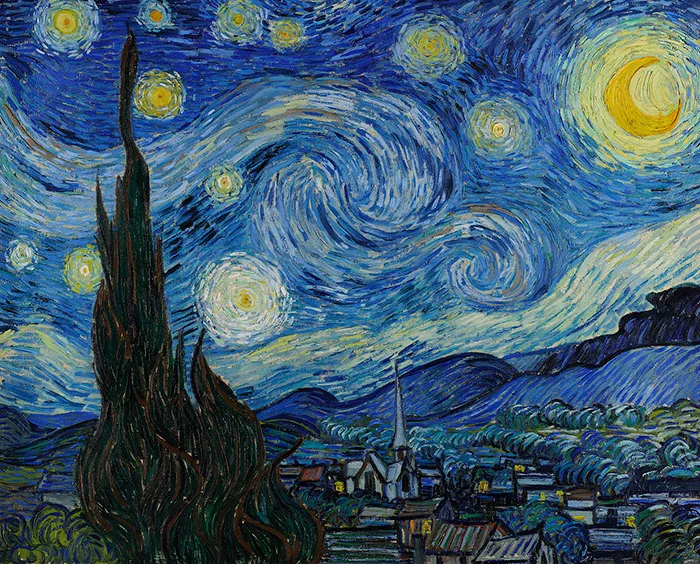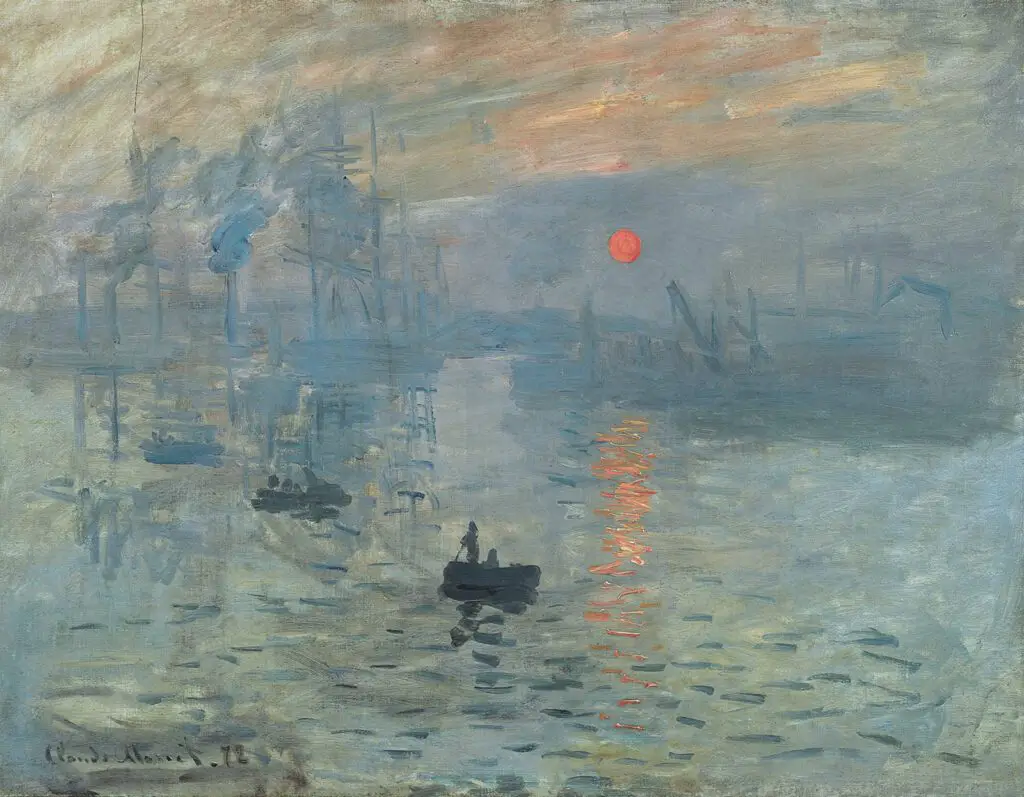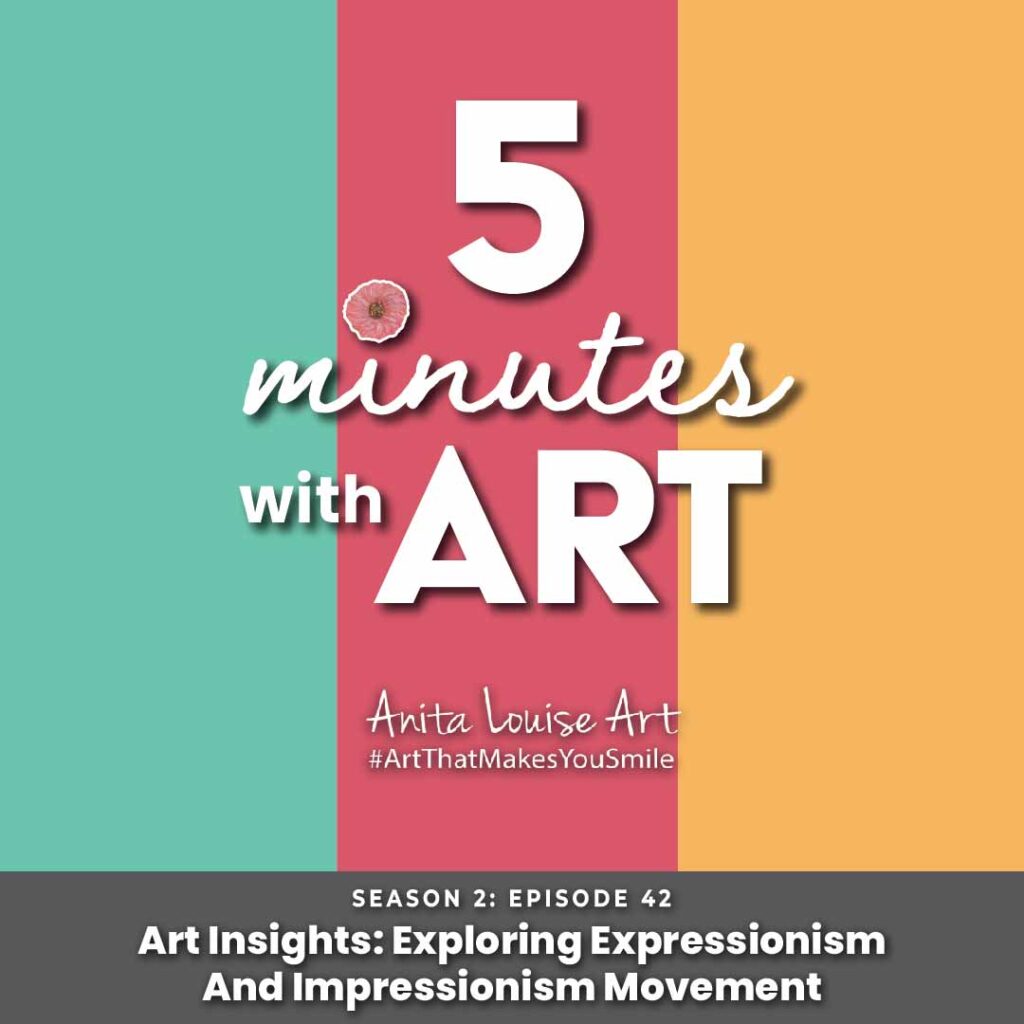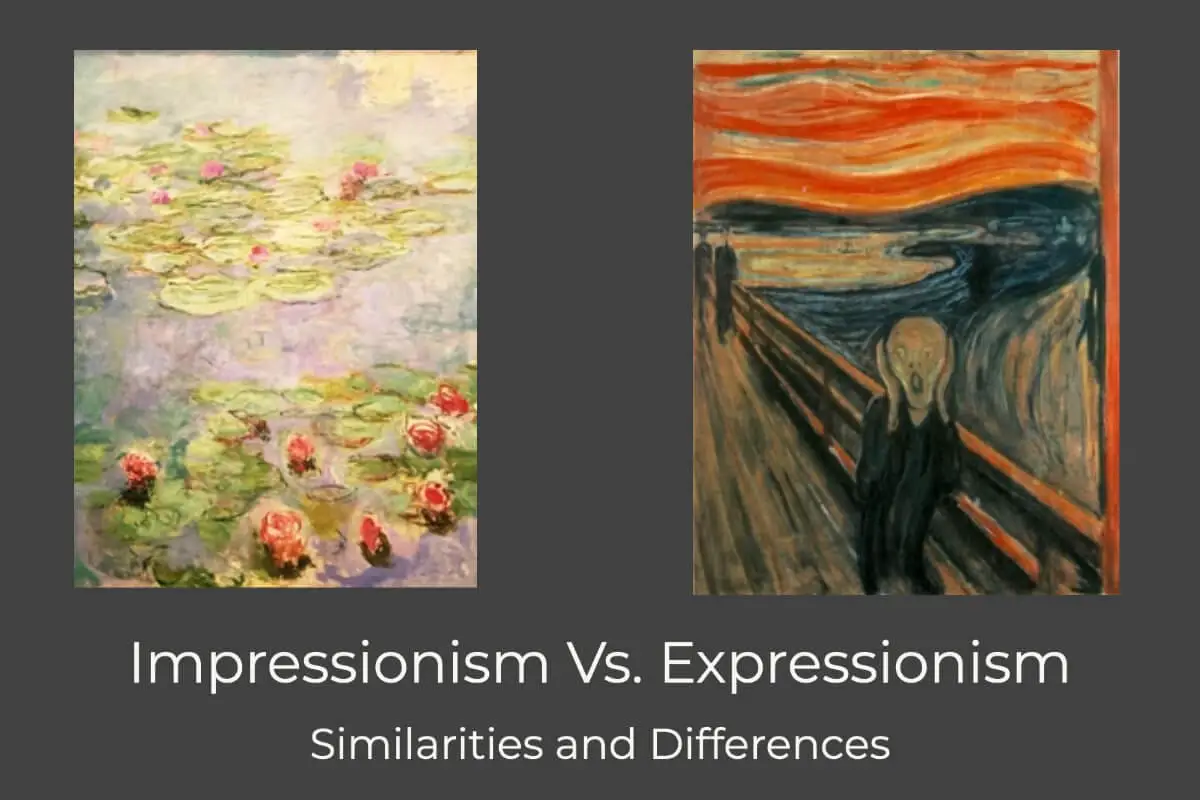The similarities and differences in Expressionism and Impressionism art movements can sometimes be confusing. Many people think they are the same art movement but are quite different.
The Impressionism and Expressionism art movements started in Europe, but the Impressionism movement started before the Expression art movement. Each movement has different looks of art, which are distinguishable from each other. Even though they are both different art movements, there are still some similarities between them.
Table of Contents
- Main Similarities Between The Expressionism And Impressionism Art Movements
- Main Differences Between Impressionism and Expressionism Art Movements
- Top 10 Impressionism Artists – Our Picks
- Top 10 Expressionism Artists – Our Picks
- Art: The Lifeline of Humanity – 10 Reasons Why It’s Essential in Our Lives
- Frequently Asked Questions
- Related Questions

Main Similarities Between The Expressionism And Impressionism Art Movements
Even though the Expressionism and Impressionism art movements are two different art movements, they also have some similarities.
Here are some of the major similarities of the Impressionism and Expressionism Art Movements:
- Both the Impressionism and Expressionism Art Movements started in Europe. Impressionism started in France, and Expressionism in Germany and Austria.
- Both the Impressionism and Expressionism Art Movements were a reaction to something that was happening outside of art. Impressionism was a reaction to rapidly changing urban environments. Expressionism was a reaction to the dehumanizing effects of industrialization.
- Both art movements received their names from a painting. The Impressionism art movement received its name from Claude Monet’s painting called Impressionism, Soleil levant (Impressionism, Sunrise). The term Expressionism received its name from a painting by Julien-Auguste Herve’ called Expressionismes (1901).
- Both art movements were a rejection from previous art movements. The Impressionism painting style was a rejection of the traditional Realist style. Expressionism was in reaction to Positivism, Naturalism, and even impressionism art movements.
- Both art movements emerged as a rejection of realism and naturalism in art; in other words, they both rejected art as merely copying what was out in the world in a realistic way.

Main Differences Between Impressionism and Expressionism Art Movements
Even though there are some similarities between the Impressionism and Expressionism art movements, they also have some differences. It is also good to understand some of their important differences to understand the similarities.
Here are some of the differences between the Impressionism and Expressionism art movements.

Impressionism Major Qualities
Here are some of the major qualities and facts of the Impressionism Art Movement:
- Impressionism is an art movement that started in Paris in the late 18th Century.
- The Impressionist artists paid special attention to depicting the impression of light and the changing effects of light. For the impressionist artist, capturing the light is extremely important.
- Because the light and changing qualities of light were so crucial to impressionist painting, many impressionist artists painted outdoors.
- Impressionism was an art movement that was a reaction to the rapidly changing urban environments.
- The Impressionism art movement made a break from the traditions in European painting.
- At first, Impressionism art was highly criticized by the other conventional artist in France. Later, impressionism became highly admired and loved.
- The Impressionism art movement derived its name from Claude Monet’s painting called Impressionism, Soleil Levant (Impressionism, Sunrise).
- Impressionism painting is more of a spontaneous painting; the artist attempts to capture the light in a scene.
- Impressionists would experiment with color to react to different colors and tones; they did not mix the colors as much as they would use the vibrant colors directly on the canvas.
- The Impressionist brushstroke was spontaneous and broad; many times, they use the painting knife.
- The Impressionist brushstroke was a spontaneous and broad brush stroke; many times, they used the painting knife.
- Many of the Impressionism paintings had unusual visual angles that had not used been used before in paintings; the visual angle of the subject matter was important.
- The Impressionism painting style was a rejection of the traditional realist style.

Expressionism Major Qualities
Here are some of the major qualities and facts of the Expressionism Art Movement:
- The Expressionism art movement emerged in the early 20th century in Germany and Austria.
- Expressionism came after the Impressionism movement.
- Expressionism art paid special attention to the artist’s personal or inner arousal and how that affected their art.
- Expressionism was the result of what the artists saw as the dehumanizing effects of industrialization.
- In Expressionism art, the artist attempted to pick the emotions and responses of events and objects that aroused something in him or her; this art movement was not about objective reality.
- Expressionism was in reaction to Positivism, Naturalism, and even Impressionism art movements.
- The term Expressionism came from a painting by Julien-Auguste Herve’ called Expressionism (1901).
- Expressionist paintings show a lot of emotion and are often described as showing a touch of the human dark side.
- Many artists incorporated fantasy and violence in their subject matter to show extreme emotions.
- The paintings show the world from a purely subjective perspective and distort the subject matter for emotional effect; the artist wants to evoke moods or ideas in the viewer’s minds.
- The artist used colors that were subjective, meaning they had no relation to the actual color of the object. (For example, a face could be green and the sky orange).

Top 10 Impressionism Artists – Our Picks
There are many great Impressionism artists to choose from, so we had a hard time deciding our top 10 picks.
Here are our picks for the top 10 Impressionism artists:
- Claude Monte (1840-1926) – Claude Monte is arguably one of the most important impressionist artists. In fact, it was his art piece that led to the naming of this entire art movement.
- Edouard Mante (1832-1883) – Most of Mante’s impressionism work consisted of Parisian life. One of his favorite things to paint was female nudes and everyday life in Paris. He also painted his sister-in-law Berthe Morisot; you can read more about their relationship by reading our blog Berthe Morisot and the Manet Brothers – Love And Impressionist Art by clicking here.
- Pierre- August Renoir (1841-1919) – Of all the impressionist artists, Renoir’s work is considered some of the most traditional kinds of impressionism. His work has a softness to it and sensuality; this is because Renoir had a special eye for beauty and an innate skill with colors.
- Edgar Degas (1834-1917) – Degas painted mainly parts of Parisian life. He also painted many human bodies, in particular females, including dancers, singers, and prostitutes. He preferred not to be called an Impressionist artist but instead an independent.
- Gustave Caillebotte (1848-1894) – Gustave Caillebotte was a French painter who tended to paint more realistic scenes than other Impressionists, but he is still considered a key Impressionism painter.
- Berthe Morisot (1841 – 1895) – One of the female impressionist artists, Berthe Morisot, was extremely talented; she was married to Edgar Degas’s brother Eugene. Her work has a softer, almost most romantic feel to it. You can read more about her by reading 7 Women Impressionist Artists, To Admire, Know and Remember by clicking here.
- Camille Pissaro (1830-1903) – Camille Pissaro is one of the Impressionism painters who is also considered to be a key post-impressionism painter
- Marie Bracquemond (1840-1916) – Marie Bracquemond is considered one of the important female Impressionism artists. You can learn more about her fascinating life by reading. You can read more about her by reading 7 Women Impressionist Artists, To Admire, Know and Remember by clicking here.
- Mary Cassatt (1844-1926) – Mary Cassatt is one of the American’s in the group who becomes an important Impressionism artist. She spent much of her adult life in France. You can read more about her by reading 7 Women Impressionist Artists, To Admire, Know and Remember by clicking here.
- Frederic Bazille (1841 – 1870) – A lot of Frederic Bazille’s work is figure painting, he would place the subject within a landscape that is painted en Plein air.

Top 10 Expressionism Artists – Our Picks
Like Impressionism, there are many great Expressionism artists to also pick from, so also had a hard time picking out our 10 ten picks.
Here are our picks for the top 10 Expressionism artists:
- Edvard Munch – (1863-1944) – Edvard Munch painted The Scream, which has become one of the most iconic and well-known artworks. They scream, and his other paintings show a very distinctive style.
- Francis Bacon – (1909 – 1992) Like many other artists, Francis Bacon is known to have painted in several art movements, including Cubism, Surrealism, and Expressionism.
- Paul Klee – (1879 – 1940) – Expressionism, Cubism, and Surrealism influenced Paul Klee’s art. His work is known to reflect his dry humor, personal moods, and sometimes childlike perspective.
- Wassily Kandinsky – (1866-1944) – Kandinsky is generally known as the pioneer of Abstract Art, but he was also actively involved in the German Expressionism and Expressionism art movements.
- Ernest Ludwig Kirchner – (1880 – 1938) – Was also a German Expressionist painter and printmaker. His work was branded as “degenerate” by the Nazis in 1933, so much of his work was destroyed or sold.
- August Robert Ludwig Macke (1887 – 1914) – August Robert Ludwig Macke was part of the German Expressionism group. He was also known to be very interested in the avant-garde movement. Unfortunately, he did not live very long as he died during World War 1.
- Egon Schiele – (1890 – 1918) – Egon Schiele is well known for his intense and raw sexuality. He painted a lot of self-portraits, including naked self-portraits.
- Franz Marc – (1880-1916) Franz Marc was one of the German expressionist art movement’s key figures. He painted a lot of animals. We served in the German Army in World War 1 and died very early.
- Marianne von Werefkin (1860-1938) – Marianne von Werefkin is not as well known as some of the other painters, but she produced some fabulous work, including a self-portrait. Her work showed some influence with Edvard Munch’s style.
- Emil Nolde (1867-1956) – German-Danish painter known for his vivid colors and expressionistic style, particularly in his depictions of landscapes and religious subjects.
When you look at the Expressionism and Impressionism art movements, you can understand their similarities and why there can be some confusion between the two movements; but upon closer examination, you will find that the two art movements are very different; the Expressionism and Impressionism art movements started at different times, have different artistic looks and different artists involved in each movement.
Art: The Lifeline of Humanity – 10 Reasons Why It’s Essential in Our Lives
Art is as old as civilization itself, a testament to its deep-rooted importance in human existence. Whether it’s ancient cave paintings or contemporary digital art, the artistic expression has always found a place in our lives.
But what gives art its enduring relevance? Here are ten reasons that underscore the omnipresence and significance of art in our lives:
- Universal Language: Art transcends boundaries, languages, and cultures. Whether through a painting, song, or dance, it speaks to our shared human experiences, making connections across diverse backgrounds.
- Emotional Resonance: Art has the profound ability to evoke emotions, from joy and nostalgia to grief and anger. It allows us to feel deeply, express freely, and connect with our innermost feelings.
- Mirror to Society: Throughout history, art has reflected societal changes, triumphs, challenges, and transformations. It provides a historical lens, offering insights into different epochs and civilizations.
- Catalyst for Change: Art challenges the status quo. Through powerful imagery, narratives, and performances, it has the potential to raise awareness, inspire movements, and bring about social or political change.
- Fosters Creativity: Engaging with art as a creator or an appreciator nurtures creativity. It encourages out-of-the-box thinking, problem-solving, and innovative approaches to challenges.
- Therapeutic Outlet: Art therapy is a testament to its healing power. Creating or experiencing art can be therapeutic, helping individuals cope with trauma, stress, and mental health issues.
- Cultural Identity and Preservation: Art captures and preserves cultural narratives, histories, and identities. Through artistic expressions, traditions and stories are passed down, ensuring that they remain alive for future generations.
- Economic Contributor: The art industry, from galleries and theaters to music festivals and film studios, plays a significant role in the global economy, generating employment, tourism, and commerce.
- Enhances Learning: Art education fosters holistic growth. Integrating art into academic curricula can improve memory, concentration, and critical thinking, making learning more engaging and effective.
- Celebration of Diversity: Art showcases the vastness and diversity of human experiences, beliefs, and perspectives. It fosters empathy and understanding, teaching us to appreciate differences and find commonalities.
Art isn’t just an ancillary aspect of life; it’s intertwined with our very existence. From personal introspection to societal reflections, art is a conduit for understanding, expression, and connection. Its universal and timeless appeal underscores its profound significance in every facet of our lives.
Listen To Our Podcast About Art Insights: Exploring Expressionism And Impressionism Movement Below or By clicking here.

Anita Louise Art is dedicated to art education, great artists, and inspiring others to find and create their art. We love art that uplifts and inspires. #ArtToMakeYouSmile!#ArtToMakeYouHappy!
If you want to see any of my art, you can find out more by clicking here. If you are interested in what inspires me and my paintings, you can discover more by clicking here.
We have a free newsletter and would love you to be part of our community; you can subscribe to the newsletter by clicking here. If you have any questions, I would be happy to talk to you. You can reach me, Anita, by clicking here.
Subscribe to our Anita Louise Art YouTube Channel filled with great videos and information by clicking here.
Frequently Asked Questions
What is the difference between Impressionism and Expressionism art?
Impressionism art is characterized by its emphasis on capturing the fleeting effects of light and color, while Expressionism art is characterized by its emphasis on the emotional experience of the artist.
When did the Impressionism and Expressionism art movements emerge?
Impressionism emerged in the late 19th century, while Expressionism emerged in the early 20th century.
Who were some of the key Impressionist artists?
Some of the key Impressionist artists include Claude Monet, Pierre-Auguste Renoir, and Edgar Degas
Who were some of the key Expressionist artists?
Some of the key Expressionist artists include Edvard Munch, Wassily Kandinsky, and Franz Marc.
What are some of the characteristics of Impressionism art?
Some of the characteristics of Impressionism art include its emphasis on light, color, and the transitory nature of the moment. Impressionist paintings often depict landscapes, seascapes, and everyday life.
What are some of the characteristics of Expressionism art?
Some of the characteristics of Expressionism art include its emphasis on emotion and the artist’s subjective experience. Expressionist paintings often depict distorted or exaggerated figures, bold colors, and dramatic brushstrokes.
How did Impressionism and Expressionism art movements differ in terms of subject matter?
Impressionism art often depicted everyday life and landscapes, while Expressionism art often dealt with more serious and emotional subject matter, such as death, alienation, and the human condition.
How did Impressionism and Expressionism art movements differ in terms of technique?
Impressionist paintings are known for their use of quick, visible brushstrokes and an emphasis on light and color, while Expressionist paintings often feature exaggerated, distorted, or abstract forms.
How did Impressionism and Expressionism art movements differ in terms of philosophy?
Impressionism art focused on capturing the moment and the effects of light, while Expressionism art focused on the emotional experience of the artist and the inner workings of the human psyche.
What is the legacy of Impressionism art?
The legacy of Impressionism art includes its influence on other art movements and its lasting impact on the way we view the world around us.
What is the legacy of Expressionism art?
The legacy of Expressionism art includes its influence on other art movements and its contribution to the development of modern art.
How do Impressionism and Expressionism art movements continue to influence art and culture today?
Impressionism and Expressionism art movements continue to influence art and culture today through their enduring legacies and the ongoing influence they have on contemporary art and design.
Related Questions
What Are The Main Characteristics Of Minimalism Art?
Minimalism art started in New York City in the 1960s. The minimalist artist would use limit their use of lines, shapes, and colors in their art. The artwork had no trace of the artist’s emotions in the art. Minimalism art is considered an extreme form of abstract art. The most important geometric shapes in minimalism art are the square and rectangle.
You can discover more by reading What Are The Main Characteristics Of Minimalism Art? by clicking here.
What Are The Characteristics Of The Arts And Crafts Movement?
The Arts and Crafts movement started in Britain and then swept over Europe and the United States. The movement started to become both popular and very influential in the late 19th century and changed how many artists around the world viewed their art. It also changed how artists saw the design of not just their artwork but also buildings, fabrics, wallpaper, parks, cities, and objects in their homes and offices.
You can learn more by reading What Are The Characteristics Of The Arts And Crafts Movement? by clicking here.

